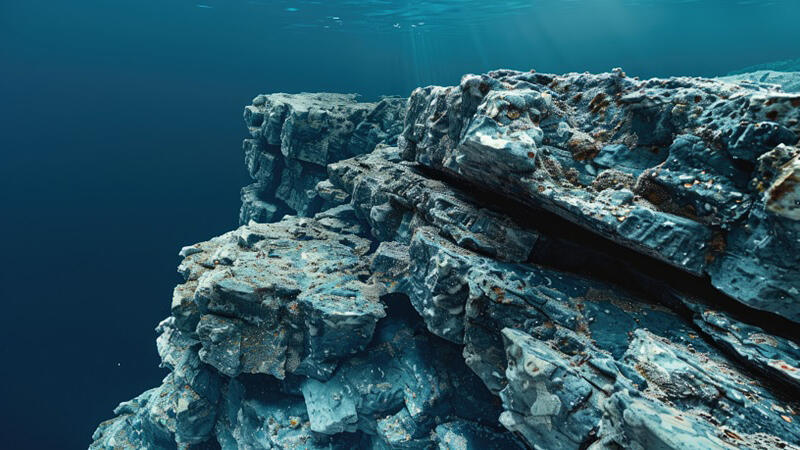During the Early Cretaceous Period, rapid global warming and anoxic water mass expansion in the oceans caused the extinction of numerous marine species. This major event, known as the Ocean Anoxic Event (OAE1a), has been extensively studied in regard to strata around Europe and the Atlantic Ocean. However, the exact date of event occurrence and its duration have remained unclear.
A research group including Professor Reishi Takashima of Tohoku University Museum and Professor Bradley S. Singer of the University of Wisconsin, USA, analyzed strata deposited in a stratum (Yezo Group) exposed northwest of Mount Ashibetsu in Ashibetsu City, Hokkaido Prefecture. They found that the ocean anoxic event occurred 119.55 million years ago and that an anoxic environment persisted over a wide area of the ocean for 1.116 million years thereafter. In addition, planktonic foraminifera fossils useful for age comparison were discovered at the top of the strata of the Yezo Group that correspond to the ocean anoxic event.
This fossil species has been reported to be obtained from limestone overlying the Ontong Java Plateau in the central Pacific Ocean, the largest undersea volcanic edifice in the Cretaceous Period, revealing that the eruption of the Ontong Java Plateau and the ocean anoxic event occurred almost simultaneously. The osmium isotope ratios of the Yezo Group, which were determined simultaneously with dating, also suggest the influence of a large-scale igneous activity at the onset of the ocean anoxic event, demonstrating that the eruption of the Ontong Java Plateau triggered the ocean anoxic event. The results were published in Science Advances.

During the Cretaceous Period, central Hokkaido was located in a semi-deep seafloor environment in the northwest Pacific Ocean adjacent to the Asian continent. Here, mud and sand accumulated on the seabed, and volcanic ash was frequently blown in from the volcanic arc formed along the eastern edge of the Asian continent, causing the frequent deposition of volcanic ash layers. The Yezo Group, which was formed in this way, is known for producing fossils of ammonites and marine reptiles.
The research group conducted the microfossil, carbon isotopic, and osmium isotopic analyses of the lower part of the Yezo Group exposed northwest of Mount Ashibetsu in central Hokkaido. They identified the layer deposited during the ocean anoxic event and discovered that it contains numerous layers of volcanic ash. Zircons were extracted from several volcanic ash layers sandwiched between the ocean anoxic event layers of the Yezo Group, and their U-Pb radiometric ages were measured using a dating device at Boise State University, USA.
The results indicate that the ocean anoxic event occurred 119.55 million years ago and that the anoxic environment spread worldwide for the next 1.116 million years. This result makes the ocean anoxic event more than 1.5 million years younger than the previously estimated date. The eruption of the Ontong Java Plateau, the largest remaining volcanic edifice on Earth, was a very likely cause for the ocean anoxic event.
Planktonic foraminifera with a unique shell called Leupoldina cabri was produced for a geologically short period of time in the strata deposited on the volcanic edifice after Ontong Java Plateau eruption. A recent report suggested that basalts from the Ontong Java Plateau are dated between 116.53 and 111.62 million years ago and that the eruption of the plateau may have occurred after the ocean anoxic event. However, the discovery of Leupoldina cabri at the top of the ocean anoxic event layer in Hokkaido and a sudden decrease in the osmium isotope ratio, which suggests a large-scale volcanic activity, at the base of the ocean anoxic event layer, indicate that most probably the ocean anoxic event was caused by the eruption of the Ontong Java Plateau.
Now that the detailed age information has been clarified, processes that led to the release of carbon dioxide and global warming due to volcanic activities, spread of anoxic water masses, and extinction of species can be revealed at high temporal resolutions. Thus, high-resolution studies of ocean anoxic events are expected to provide important indicators for evaluating future climate and environmental changes and their impacts on ecosystems if global warming progresses further in the future.
Journal Information
Publication: Science Advances
Title: Radioisotopic chronology of Ocean Anoxic Event 1a: Framework for analysis of driving mechanisms
DOI: 10.1126/sciadv.adn8365
This article has been translated by JST with permission from The Science News Ltd. (https://sci-news.co.jp/). Unauthorized reproduction of the article and photographs is prohibited.




